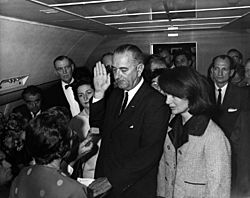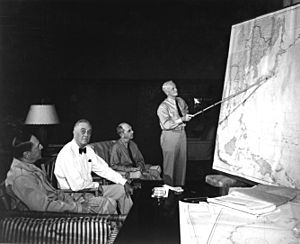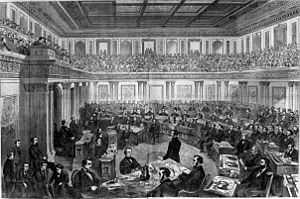Article Two of the United States Constitution facts for kids
Article Two of the U.S. Constitution sets up the executive branch of the U.S. government. This branch is in charge of carrying out the country's laws. It includes the President, the Vice President, and the Cabinet. It also includes many government departments and agencies, like the Department of State and the CIA.
Contents
- The President and Vice President
- Presidential Powers
- Presidential Responsibilities
- Impeachment
- Images for kids
- See also
The President and Vice President
What is the President's main job?
The Constitution says that the President is the head of the executive branch. This means the President has the power to lead the government and make sure laws are followed. This is part of the idea of separation of powers. The people who wrote the Constitution wanted to prevent any part of the government from becoming too strong. So, they divided power among three main branches:
- The executive branch (led by the President) carries out laws.
- The legislative branch (Congress) makes laws.
- The judicial branch (federal courts) explains laws.
Each branch has its own job. For example, the President cannot make laws. That is Congress's job. The President and Vice President are elected at the same time for a four-year term.
How are the President and Vice President chosen?
The President and Vice President are chosen by special people called Electors. Each state gets a certain number of Electors. This number is equal to the total number of Senators and Representatives the state has in Congress. For example, if a state has 2 Senators and 10 Representatives, it gets 12 Electors.
States decide how to choose their Electors. Since the 1820s, most states have used a popular vote. This means people vote for the Presidential and Vice Presidential candidates they want. The Electors who support the winning candidates in that state then cast their votes.
Senators, Representatives, and other federal officers cannot be Electors. This rule helps make sure that regular Americans, not just politicians, are part of the Electoral College.
How Electors vote for President
Electors meet in their states to vote for President and Vice President. Originally, Electors voted for two people for President. The person with the most votes became President. The person with the second most votes became Vice President.
The Constitution also explains what happens if there is a tie or if no one gets enough votes:
- Ties: If two candidates tie for President, the House of Representatives chooses the President. If there is a tie for Vice President, the Senate chooses.
- No majority: If no candidate gets more than half of the votes, the House of Representatives chooses from the top five candidates.
- Quorum: For the House and Senate to choose a President or Vice President, a certain number of members must be present. This is called a quorum.
How the 12th Amendment changed elections
The Twelfth Amendment, passed in 1804, changed how Electors vote.
- Now, Electors vote separately for one Presidential candidate and one Vice Presidential candidate.
- If no Presidential candidate gets more than half the votes, the House chooses from the top three candidates.
- If no Vice Presidential candidate gets more than half the votes, the Senate chooses from the top two candidates.
- To be Vice President, a person must meet the same requirements as the President.
When is Election Day?
Article Two lets Congress set a national Election Day. This day must be the same across the entire United States.
What are the requirements to be President?
To become President, a person must meet three main requirements:
- They must have been born in the United States (a "natural born Citizen").
- They must be at least 35 years old.
- They must have lived in the United States for at least 14 years.
If someone does not meet all these requirements, they cannot be President.
How amendments changed these rules
- The Twelfth Amendment (1804) made sure that the Vice President must also meet all three of these requirements.
- The Twenty-second Amendment (1951) set a limit. A President cannot be elected more than twice.
What happens if the President cannot do their job?

This part of the Constitution talks about what happens if the Presidency becomes "vacant". This can happen if:
- Congress removes the President from office (this is called impeachment).
- The President dies.
- The President resigns (quits).
- The President is unable to do their job, for example, because of a serious illness. This is known as the Disability Clause.
If the Presidency becomes vacant, the Vice President becomes President. If the Vice President also cannot serve, Congress decides who will take over. This person acts as President until the actual President gets better or a new President is elected.
Congress has created a "line of succession". This is a list of people who would become President, and in what order, if both the President and Vice President could not serve. The list starts with the Speaker of the House and then the President pro tempore of the Senate. After them come the Cabinet Secretaries, in the order their departments were created.
The 25th Amendment and presidential disability
The Twenty-fifth Amendment (1967) updated these rules. It created a way to fill a vacant Vice President position. It also explains how a Vice President can become "Acting President" (a temporary President) if:
- The President says they cannot do their job.
- The Vice President and most of the Cabinet agree that the President cannot do their job.
If the President says they are unable to do their job, they can take back the Presidency at any time. For example, in 2002, George W. Bush temporarily gave power to his Vice President, Dick Cheney, for about two hours while he had a medical test. Once he was ready, Bush took back the Presidency.
If the Vice President and Cabinet say the President cannot do their job, the President can try to take back control. But if the Vice President and Cabinet still disagree, Congress can vote. If two-thirds of both the House and Senate agree, the President is declared unable to do their job, and the Vice President stays in charge.
Does the President get paid?
The President receives a salary for their work. This salary cannot be changed during their four-year term. Also, the President cannot receive any other salary from the federal government or any state government while in office.
What oath does the President take?
Before becoming President, the new President must take an Oath or affirmation. They promise to faithfully do their job and to protect the Constitution. Usually, the Chief Justice of the United States gives this oath at the President's inauguration.
Presidential Powers
This section explains the powers that the Constitution gives to the President.
What are the President's military and pardon powers?

(Left to right: General Douglas MacArthur; Roosevelt; Admiral William D. Leahy; & Admiral Chester W. Nimitz)
The Constitution gives the President the most power in areas related to national security.
- The President is the military's Commander-in-Chief. This means they lead the Army and Navy. However, only Congress can declare war. Still, the President can send soldiers to different places without Congress's approval.
- The President can ask for written advice from the heads of executive departments. These heads often form the President's Cabinet.
- The President can grant pardons or reprieves to people convicted of crimes. A "reprieve" can change a punishment, like changing a death sentence to prison time. However, the President cannot pardon someone who has been impeached.
How does the President make treaties and appointments?
This part of the Constitution is called the Advice and Consent Clause. It gives the President powers, but they must use them with the Senate's agreement. This is another example of checks and balances.
Treaties with other countries
The President has the power to make treaties with other countries. But, two-thirds of the Senators must agree to the treaty for it to become official. If the Senate does not agree, the treaty is not approved.
The Constitution does not say how the U.S. can end a treaty. Over time, this has been done in different ways. Sometimes Congress passes a law to end a treaty. Other times, Presidents have ended treaties after Congress asked them to.
Appointing government officials
The President also chooses judges, ambassadors, and other important government officers. But again, the Senate must give its "advice and consent" (agreement).
Congress can allow the President, department heads, or courts to appoint less important officials without needing Senate approval. Once the Senate approves a person for a job, they cannot change their mind and take back their approval. However, the President can still decide not to give the job to the person they nominated.
It is not always clear if the President can fire someone who was approved by the Senate. Congress has tried to limit this power many times.
What are recess appointments?
This clause deals with times when the Senate is not meeting. This is called a "recess." In the past, travel was slow, so Congress would meet only during planned "sessions." After these sessions, Senators would go home.
During a Senate recess, the President can appoint temporary officers to fill vacancies. These temporary appointments end when the Senate finishes its next session.
Presidential Responsibilities
What is the State of the Union?
The President must "from time to time" give Congress information on the "State of the Union." This means telling Congress about the "situation in the United States."
Originally, Presidents gave these speeches in person every year. Later, Presidents like Thomas Jefferson sent written messages instead. But since President Woodrow Wilson, Presidents have gone back to speaking in front of Congress.
The State of the Union address helps the President share information with Congress and the country. This information helps Congress decide if new laws are needed. It also keeps people informed about their government.
Can the President suggest new laws?
The President can suggest to Congress anything they think is "necessary and expedient" (needed and appropriate). This is called the Recommendation Clause.
This clause is another part of checks and balances. The President cannot just do whatever they think is needed. They must get Congress's approval. If the President makes suggestions, Congress can approve them. But Congress cannot force the President to make suggestions.
By asking Congress, the President shows that they respect Congress as an equal part of the government.
Can the President call special meetings of Congress?
The President can call one or both Houses of Congress together for "extraordinary Occasions." This allows the government to act quickly if a major emergency happens when Congress is not meeting. If the two Houses of Congress cannot agree on when to end a special meeting, the President can end it when they think it is right.
Presidents have called special sessions 27 times to deal with crises like wars or economic emergencies. The last time was in 1948, when President Harry S. Truman called a session to try to pass civil rights and health care laws. Since around the 1950s, Congress usually meets all year, so special sessions are no longer needed.
Does the President meet with foreign leaders?
The President receives (greets and hosts) all foreign Ambassadors. This part of the Constitution is called the Reception Clause. It means the President is the main person who represents the U.S. when dealing with other countries.
What does "faithfully execute the law" mean?
The President must "take care that the laws be faithfully executed" (used and followed). This is known as the Take Care Clause.
This clause gives the President power, limits, and a duty:
- Power: To carry out laws in a legal and constitutional way.
- Limit: The President cannot ignore laws or refuse to follow parts of the Constitution.
- Duty: To carry out laws (even if they disagree with them). The President must also make sure other parts of the government follow the laws.
The Supreme Court has said that the President must make sure everyone in the executive branch follows laws made by Congress. The President cannot stop enforcing laws they do not like. Also, if Congress approves money for a program, the President cannot refuse to spend that money on the program.
Who does the President give commissions to?
The President gives "commissions" to "all the Officers of the United States." This means the President gives these officers the official power to do their jobs. This includes officers in the military and people who work for the U.S. government in other countries, like Ambassadors. However, each state has the power to appoint officers in its own militias.
Impeachment

The Constitution allows certain government officials to be removed from office. The President, Vice President, Cabinet Secretaries, and judges can be impeached by the House of Representatives. Then, they can be tried in the Senate.
Officials can be impeached for Treason, Bribery, or other "High crimes and Misdemeanors" (serious wrongdoings). If someone is found guilty by impeachment, they are immediately removed from their job. The Senate can also decide to prevent them from holding any federal office in the future. These are the only punishments an impeachment can give. However, the person can still be tried for other charges in court and punished if found guilty.
Impeachment is a power only Congress has. The Supreme Court has said that it cannot review or change the Senate's decision in an impeachment trial. This power helps Congress make sure that executive officials and judges are not acting corruptly.
Images for kids
-
George Washington's inauguration as the first U.S. president (1789)
-
In this 1944 poster, Franklin D. Roosevelt (left) successfully campaigned for a fourth term. He was the only president who served more than two terms.
-
1888 illustration of new President John Tyler receiving the news of President William H. Harrison's death.
-
President Barack Obama being administered the oath of office by Chief Justice John Roberts for the second time at his first inauguration (2009).
See also
 In Spanish: Artículo II de la Constitución de los Estados Unidos para niños
In Spanish: Artículo II de la Constitución de los Estados Unidos para niños








